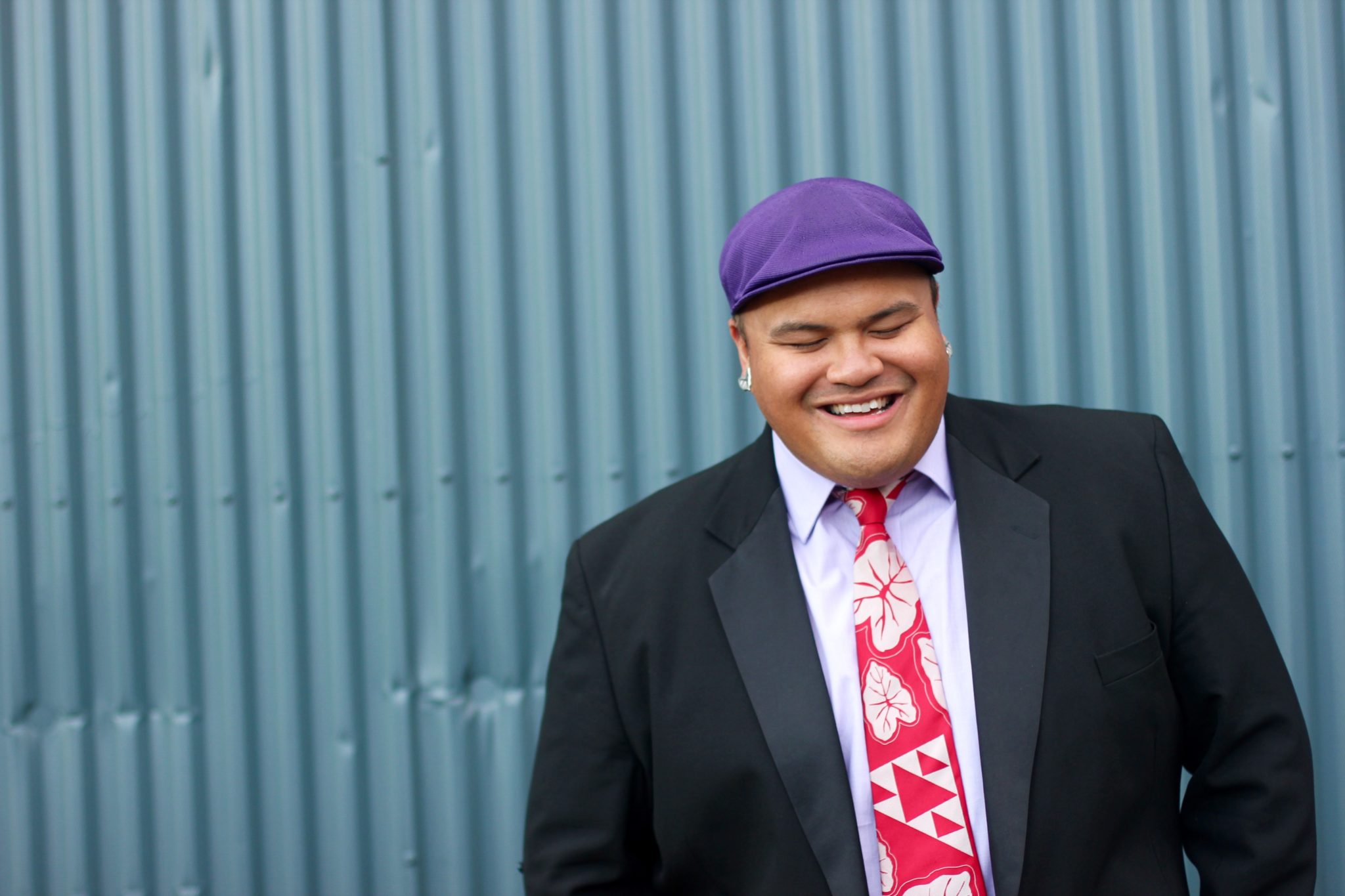Inspired by the Hawaiian Islands, a sense of self, and honoring his community, Kalani Peʻa has created a modern Hawaiian album perfect for enjoying alone or in the company of another.
Featured photo by Allan Cool
Photos below by John Hook
At the age of 33, Kalani Peʻa has debuted his first album, E Walea, which means to be exuberant, to enjoy one another’s company, and to be elated. The musician matches his album title perfectly—he shares the beauty of the islands, and of being true to yourself, both in his personal style (he will wear an aloha shirt with a Lauhala bowtie, Versace prescribed glasses, and Calvin Klein loafers for dinner at the beach) and in the music he creates, which is influenced by Hawaiian, contemporary, soul, and R&B.
While he now lives on Maui with his fiancé, makeup artist Allan Cool, Peʻa was raised on Hawaiʻi Island, where he learned the Hawaiian language at a young age, and began singing at the age of four.
He has a full-time job is as an educator and Hawaiian resource coordinator at Kamehameha Schools, but instead of his position distracting him from his musical passion, it motivates him, and enriches the stories he tells through song.
E Walea means to be exuberant, to enjoy each otherʻs company, and to be elated.
The Lei Interview
We had a conversation with Peʻa about what it was like growing up in Hawaiʻi, about special places he likes to spend his time, and about things he wants you to know. Check it out below, and then download his soulful album on iTunes.
What was unique about growing up in Hawaiʻi?
I was born and raised in the piko (umbilical chord) or the puʻuwai (heart) of the world. Hawaiʻi is my wahi pana (special place), with every essential natural and cultural resource available to me, from the lani (heavens) to the kuahiwi (mountains), the pali (cliffs) to the kahawai (streams), and the pua (flowers) that bloom, the kalo (taro) that feeds us, the moana (ocean), the driving rain, the cumulus clouds, Hawaiʻi is my puʻuhonua (a place of peace and safety).
What is a favorite childhood memory?
One of my favorite childhood memories is eating green or partially ripe guava mixed with aloha shoyu, brown sugar, and vinegar. I grew up on 25 acres on Panaʻewa homestead in Hilo, then we moved to my fatherʻs homestead, located on five acres in Panaʻewa. I remember the innumerable guava trees, and attempting to mow two acres of land, complaining about doing it.
One of my favorite childhood memories is eating green or partially ripe guava mixed with aloha shoyu, brown sugar, and vinegar.
How were you able to become fluent in Hawaiian at such a young age?
Ua ʻaha hoʻomōloa a puka hanohano au me koʻu mau kaikaina me koʻu kaikuahine mai ke Kula ʻO Nāwahīokalaniʻōpuʻu. Pueko a walewaha kākou a pau i ka ʻŌlelo Makuahine. ʻO wau ka makahiapo o ka ʻohana. Ua hoʻomaka au ma ka Papa 3 e aʻo i ka ʻŌlelo Hawaiʻi ma ke Kula Kaiapuni ʻo Keaukaha ma Hilo. Ma laila nō i komo ke kuko a me ka ʻiʻini e walewaha i ka ʻŌlelo Hawaiʻi. All of my siblings graduated from Ke Kula ‘o Nāwahīokalani’ōpu’u. We all speak [Hawaiian] fluently. I’m the eldest of four. I started in the Hawaiian Immersion Program in third grade at Ke Kula Kaiapuni ‘o Keaukaha in Hilo. That is where the passion and love of Hawaiian language started.
How did you get into music?
By age four, my parents realized I had a speech impediment—I stammered and stuttered, and speech therapy didn’t help. So my mom decided to sing to me. My father, Arthur Peʻa, a musician, said that music would help. It started with me serenading manikins at JCPenney in the old Kaikoʻo Mall in Hilo. It continued with “ʻekahi is one, ʻelua is two” nursery songs, then singing religious tunes like “I Feel My Savior’s Love.” My mom entered me into numerous karaoke and talent competitions statewide, which I won. Singing helped me.
What were inspirations for your album?
E Walea means to be exuberant, to enjoy each otherʻs company, and to be elated. Walea is also the name of my eldest nephew, Kamāliʻikānekūikekaipūʻoluwaleaokalani. I wanted to honor my nieces and nephews. I wanted to honor my kūpuna (ancestors), my parents, my family, my friends, and loved ones who believe in the success of our Hawaiian nation. I wanted to honor the Hawaiian language and culture, and exude ways of being proud of who I am, what I am capable of doing.
What inspired one of your seven haku mele in this new album?
I wanted to feature composer Devin Kamealoha Forrest. For my duet with Nani Lim Yap, “He Wehi Aloha”—a song that describes, in great kaona (hidden messages), one’s love compared to the beauty of Maunawili on O’ahu—and “Hanalei I Ka Pilimoe” (Devin is from Hanalei, on Kauaʻi), Devin composed the lyrics and I created the music and melody. He was also my co-composer for “He Lei Aloha (No Hilo),” which acknowledges a lofty flower, the naupaka flower.
Who are a couple of your favorite local musicians?
I look up to Genoa Keawe, The Lim Family, and Helen Desha Beamer. However, I idolize singers like Luther Vandross and opera singers like Luciano Pavarotti.
Where is your favorite place to unwind and relax?
I like to relax at my favorite beach in the world, Hāmoa, in Hāna, or at Spa Grande at Wailea with the fiancé. I also like to sing some karaoke tunes at L’ava’s Sports Bar in Wailuku.
Where is your favorite place to get a bite to eat?
I love Saeng’s Thai Cuisine in Wailuku. I love the Yellow Chicken Curry and Chicken Evil Prince… Mmmmm ʻono! I also enjoy the beef and lamb gyro salads from Z-man’s Kitchen in Wailuku. I could eat that every single day.
What is your favorite mantra?
“Boom Kanani!” Boom, everything is exquisite. Everything is beautiful. Like my last song on my album, “Nani a Maikaʻi.” There is beauty everywhere, beauty in our challenges, beauty in our efforts, beauty all around.
There is beauty everywhere, beauty in our challenges, beauty in our efforts, beauty all around.
How did you and Allan meet?
Allan was checking me out at his retail store in Kailua-Kona in 2008. I knew he was talented in makeup artistry, doing makeup on local celebrities like Nani Lim Yap, Kimié Miner, Anuhea, Lorna Lim, Raiatea Helm. Allan added me on MySpace and told me that he was attracted to big Hawaiian boys. I made him wait three months because I wanted to get to know him. I am his first love. Allan is the love of my life. He is my best friend. He is my music manager, my financial advisor, my soulmate, my balance, my heart, my iwikuamo’o (backbone), my life. Allan is the person I vent to. He is my lifetime partner. We have been together for eight years now.
Where is somewhere you two like to go on a date?
We like to have dinners at restaurants like Roy’s in Lāhainā, or high-end restaurants like Haliʻimaile General Store or Lāhainā Grille, or drink black coffee while listening to music or reading books in bookstores. We don’t do nightclubs like Kona anymore. We’re dorks, I know.
How did you get engaged?
Allan and I attended a concert of the famous Robert Cazimero at the Shops of Wailea about a year ago. It was a gibbous moon phase and starry night. We decided to try on some koa tungsten rings from Martin and MacArthur. After seven years, we realized it was time to propose to each other. We plan to get married during the CD release on Hawai’i Island, when the Lim Family can serenade us.
Where can people see you perform?
I prefer singing and creating music [to performing]. I love to record music and create melodies. People can see me perform on YouTube, or see my updates at kalanipeamusic.com.
Allan is the love of my life. He is my best friend. He is my music manager, my financial advisor, my soulmate, my balance, my heart, my iwikuamo’o (backbone), my life.
What is something you wish people knew about the islands?
When you are on Mauna Kea playing with snow during the wintertime, you can haul snow from the mountain to the ocean in less than two hours. Also, we are not all Samoan. I’m Hawaiian and Filipino. I love our diverse cultures and our willingness to learn about each other’s norms, customs, and values. I love poi, ‘a’ama crab, and fried fish with black coffee.
What do you hope people take away from your music?
It is through Hawaiian music and poetry that we share our moʻolelo (stories). I want to leave hoʻoilina (legacies) for my family, my students, and the communities we serve through higher education, and through creating Hawaiian music.




